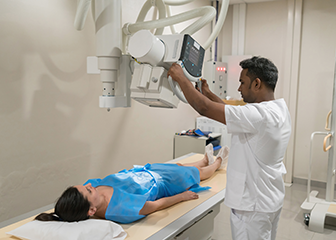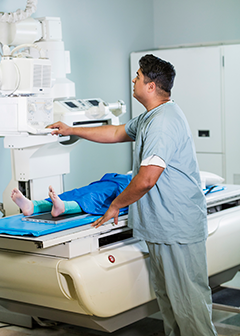Radiologic or MRI Technologist
Radiologic or MRI Technologist
Does this career fit your work personality?
Begin The Career Assessment Test- Best Fitting Careers
- Work Personality Strengths
- Work Style Preferences
- and more
Job Outlook
Overall employment of radiologic and MRI technologists is projected to grow 6 percent from 2022 to 2032, faster than the average for all occupations.
About 15,700 openings for radiologic and MRI technologists are projected each year, on average, over the decade. Many of those openings are expected to result from the need to replace workers who transfer to different occupations or exit the labor force, such as to retire.
What Radiologic and MRI Technologists Do
Radiologic technologists, also known as radiographers, perform x rays and other diagnostic imaging examinations on patients. MRI technologists operate magnetic resonance imaging (MRI) scanners to create diagnostic images.
Duties
Radiologic and MRI technologists typically do the following:
- Adjust and maintain imaging equipment
- Follow precise orders from physicians on what areas of the body to image
- Prepare patients for procedures, including taking a medical history and shielding exposed areas that do not need to be imaged
- Position the patient and the equipment in order to get the correct image
- Operate the computerized equipment to take the images
- Work with physicians to evaluate the images and to determine whether additional images need to be taken
- Keep detailed patient records
Radiologic technologists are trained in the use of different types of medical diagnostic equipment. They may choose to specialize, such as in x-ray, mammography, or computed tomography (CT) imaging. Some radiologic technologists provide a mixture for the patient to drink that allows soft tissue to be viewed on the images that the radiologist reviews.
MRI technologists specialize in magnetic resonance imaging scanners. They inject patients with contrast media, such as a dye, so that the images will show up on the scanner. The scanners use magnetic fields in combination with the contrast agent to produce images that a physician can use to diagnose medical problems.
For information about healthcare workers who specialize in other diagnostic equipment, see the profiles for nuclear medicine technologists and diagnostic medical sonographers, and cardiovascular technologists and technicians, including vascular technologists.

Work Environment

Magnetic resonance imaging technologists held about 41,400 jobs in 2022. The largest employers of magnetic resonance imaging technologists were as follows:
| Hospitals; state, local, and private | 56% |
| Medical and diagnostic laboratories | 18 |
| Offices of physicians | 14 |
| Outpatient care centers | 3 |
Radiologic technologists and technicians held about 222,800 jobs in 2022. The largest employers of radiologic technologists and technicians were as follows:
| Hospitals; state, local, and private | 58% |
| Offices of physicians | 18 |
| Medical and diagnostic laboratories | 7 |
| Outpatient care centers | 7 |
| Federal government, excluding postal service | 3 |
Radiologic and MRI technologists are often on their feet for long periods and may need to lift or turn patients, such as to help those who are injured.
Injuries and Illnesses
Like other healthcare workers, radiologic and MRI technologists may be exposed to infectious diseases. In addition, because radiologic technologists work with imaging equipment that uses radiation, they must wear badges that measure radiation levels in the radiation area. Detailed records are kept on their cumulative lifetime dose. Although radiation hazards exist in this occupation, they are minimized by the use of protective lead aprons, gloves, and other shielding devices and by the badges that monitor exposure to radiation.
Work Schedules
Most radiologic and MRI technologists work full time. Because imaging is sometimes needed in emergency situations, some technologists work evenings, weekends, or overnight.
Getting Started
How to Become a Radiologic or MRI Technologist

Radiologic technologists and MRI technologists typically need an associate’s degree. MRI technologists may start out as radiologic technologists. Most states require radiologic technologists to be licensed or certified, but few states require licensure for MRI technologists. Regardless of state requirements, employers typically require or prefer to hire technologists who are certified.
Education
High school students who are interested in radiologic or MRI technology should take courses that focus on math and science, such as anatomy, biology, chemistry, and physics.
An associate’s degree is the education typically required for radiologic and MRI technologists. There also are postsecondary education programs that lead to graduate certificates or bachelor’s degrees in healthcare and related fields and science technologies. Depending on the field of degree, education programs may include both academic study and clinical work. Coursework includes anatomy, pathology, patient care, radiation physics and protection, and image evaluation.
The Joint Review Committee on Education in Radiologic Technology (JRCERT) accredits programs in radiography and magnetic resonance, and the American Registry of Magnetic Resonance Imaging Technologists (ARMRIT) accredits MRI programs. Some states require candidates for licensure to complete an accredited program.
Work Experience in a Related Occupation
MRI technologists typically need less than 5 years of experience in a related occupation, most often from working as a radiologic technologist.
Licenses, Certifications, and Registrations
Most states require radiologic technologists to be licensed or certified. Few states require licensure for MRI technologists. Requirements vary by state.
To become licensed, technologists usually must graduate from an accredited program and either pass a certification exam from the state or obtain certification from a credentialing organization. Technologists may be certified in multiple specialties. Certifications for radiologic technologists are available from the American Registry of Radiologic Technologists (ARRT). Certification for MRI technologists is available from the ARRT and from the American Registry of Magnetic Resonance Imaging Technologists (ARMRIT). For specific licensure requirements for radiologic technologists and MRI technologists, contact the state’s health board.
Employers typically require or prefer prospective technologists to be certified even if the state does not require it. Employers also may require or prefer that prospective technologists have certification in cardiopulmonary resuscitation (CPR) or basic life support (BLS).
Contacts for More Information
For more information about radiologic and MRI technology, visit
American Society of Radiologic Technologists
Joint Review Committee on Education in Radiologic Technology
American Registry of Radiologic Technologists
American Registry of Magnetic Resonance Imaging Technologists
Similar Occupations
This table shows a list of occupations with job duties that are similar to those of radiologic and MRI technologists.
| Occupation | Job Duties | Entry-Level Education | Median Annual Pay, May 2022 | |
|---|---|---|---|---|

|
Diagnostic Medical Sonographers and Cardiovascular Technologists and Technicians |
Diagnostic medical sonographers and cardiovascular technologists and technicians operate special equipment to create images or to conduct tests. |
Associate's degree | $78,210 |

|
Nuclear Medicine Technologists |
Nuclear medicine technologists prepare and administer radioactive drugs for imaging or treatment. |
Associate's degree | $85,300 |

|
Radiation Therapists |
Radiation therapists administer doses of radiation to patients who have cancer or other serious diseases. |
Associate's degree | $89,530 |

|
Veterinary Technologists and Technicians |
Veterinary technologists and technicians do medical tests that help diagnose animals’ injuries and illnesses. |
Associate's degree | $38,240 |
